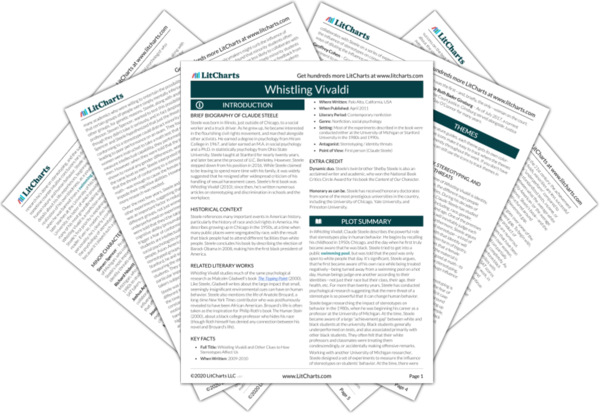Summary
Analysis
Since the election of Barack Obama in 2008, there’s been a lot of talk about America becoming a “post-racial” society. In Whistling Vivaldi, Steele has tried to advance a more nuanced argument. Even if Americans abandon all racial prejudices overnight, they’d still have to deal with identity contingencies—the fear of being perceived as racist, and the fear of confirming other people’s prejudices. The unfortunate reality is that identity threats continue to influence people’s behavior, whether they’re aware of it or not.
The election of a black president was celebrated by some as a sign that “racism is dead” in America. However, the events of Obama’s presidency, including police brutality against black people and the circulation of the myth that Obama wasn’t born in the United States, suggest that this simply isn’t true. But instead of talking about these overt, hostile displays of bigotry, Steele instead discusses examples of people altering their behavior to avoid seeming racist, or to avoid confirming a stereotype.
Themes
Perhaps the most important thing Steele has discovered during the course of his career is that even the threat of being negatively stereotyped can change a person’s behavior in important ways—even behaviors such as track competitions, or taking a math test, that seem to have nothing to do with race or gender. People who formulate policy need to understand that it’s not enough to eliminate prejudice itself—people also need to feel safe from the risk of “identity predicaments,” or there will continue to be an achievement gap.
As long as policymakers neglect Steele’s research, Steele suggests, there will continue to be an achievement gap. This is because, even if standardized tests are supposed to be unbiased, and even if people of all identities are equally successful and ambitious, people of certain identities will continue to suffer from stereotype threats that affect their performance.
Themes
In all, Steele hopes that Whistling Vivaldi can be an optimistic book. He’s detailed a variety of techniques, including critical feedback, narrative formation, and fostering intergroup conversation, that contribute to the weakening of identity threats, and seem to lead to greater success for minorities.
Steele admits that there’s much more research to be done about how to implement changes that can reduce stereotype anxiety. However, he’s described some tentative solutions to the problem, which future researchers and policymakers should explore in more depth.
Themes
The irony is that, even though Obama’s election was widely hailed as a sign of the advent of post-racial America, Obama spoke about his race often (Steele says), and celebrated his heritage. Obama talked about his white mother and his black father, and about how he has family members “of every race and every hue.” By speaking about his own racial experience, Obama inspired many people—including millions of people who didn’t share his racial makeup. Obama also signaled that race isn’t an “unalterable essence.” Rather, race—and identity in general—is fluid, and it’s “activated by [its] situational relevance.” Identity shouldn’t be ignored or suppressed—rather, people should celebrate their identities and use them to understand other people’s identities. Steele hopes that Whistling Vivaldi can impart a similarly hopeful, optimistic message about the future of identity in America.
Steele began his book by discussing the segregation of Chicago in the 1950s. He ends the book by discussing the rise of a brilliant, black, Chicago-based politician—Barack Obama. In this way, Steele seems to be taking an optimistic view of recent American history. Many of the racial obstacles that Steele had to deal with as a child are now nonexistent. However, this doesn’t mean that black people don’t have to deal with stereotyping, or the threat of stereotyping, anymore. Steele concludes by making a point that he’s suggested throughout the book: Americans shouldn't try to hide their identities. Rather, they should celebrate their identities, while also understanding that identity, and society’s awareness and perception of identity, plays a huge role in dictating behavior.
Themes
Get the entire Whistling Vivaldi LitChart as a printable PDF.













